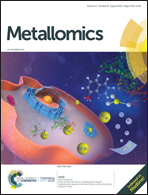Dealing with Cu reduction in X-ray absorption spectroscopy experiments
Abstract
In this paper we prove in the exemplary case of the amyloid-β peptide in complex with Cu(II) that at the current low temperatures employed in XAS experiments, the time needed for collecting a good quality XAS spectrum is significantly shorter than the time after which structural damage becomes appreciable. Our method takes advantage of the well-known circumstance that the transition of Cu from the oxidized to the reduced form under ionizing radiation can be quantified by monitoring a characteristic peak in the pre-edge region. We show that there exists a sufficiently large time window in which good XAS spectra can be acquired before the structure around the oxidized Cu(II) ion reorganizes itself into the reduced Cu(I) “resting” structure. We suggest that similar considerations apply to other cases of biological interest, especially when dealing with macromolecules in complex with transition metal ions.



 Please wait while we load your content...
Please wait while we load your content...